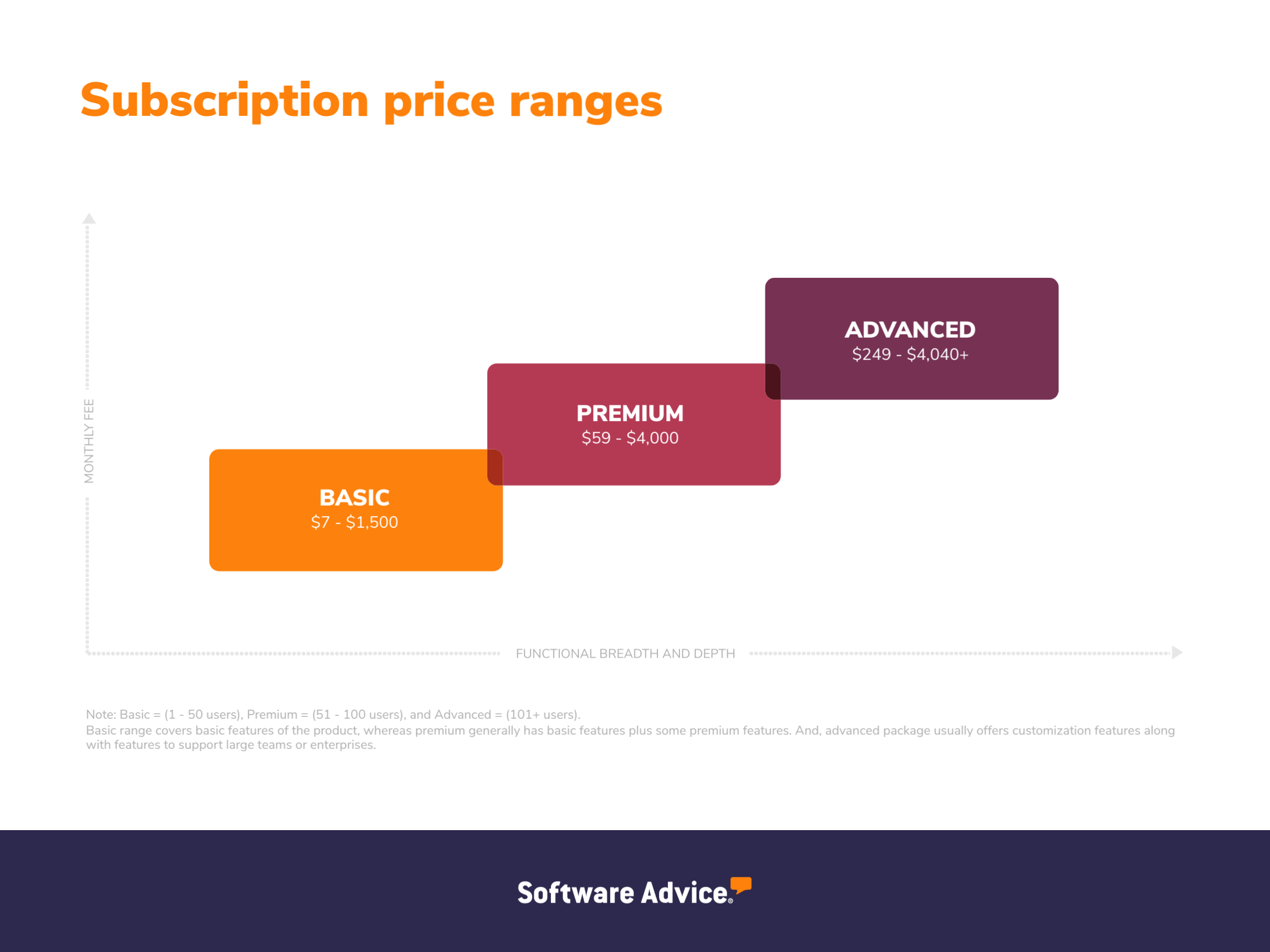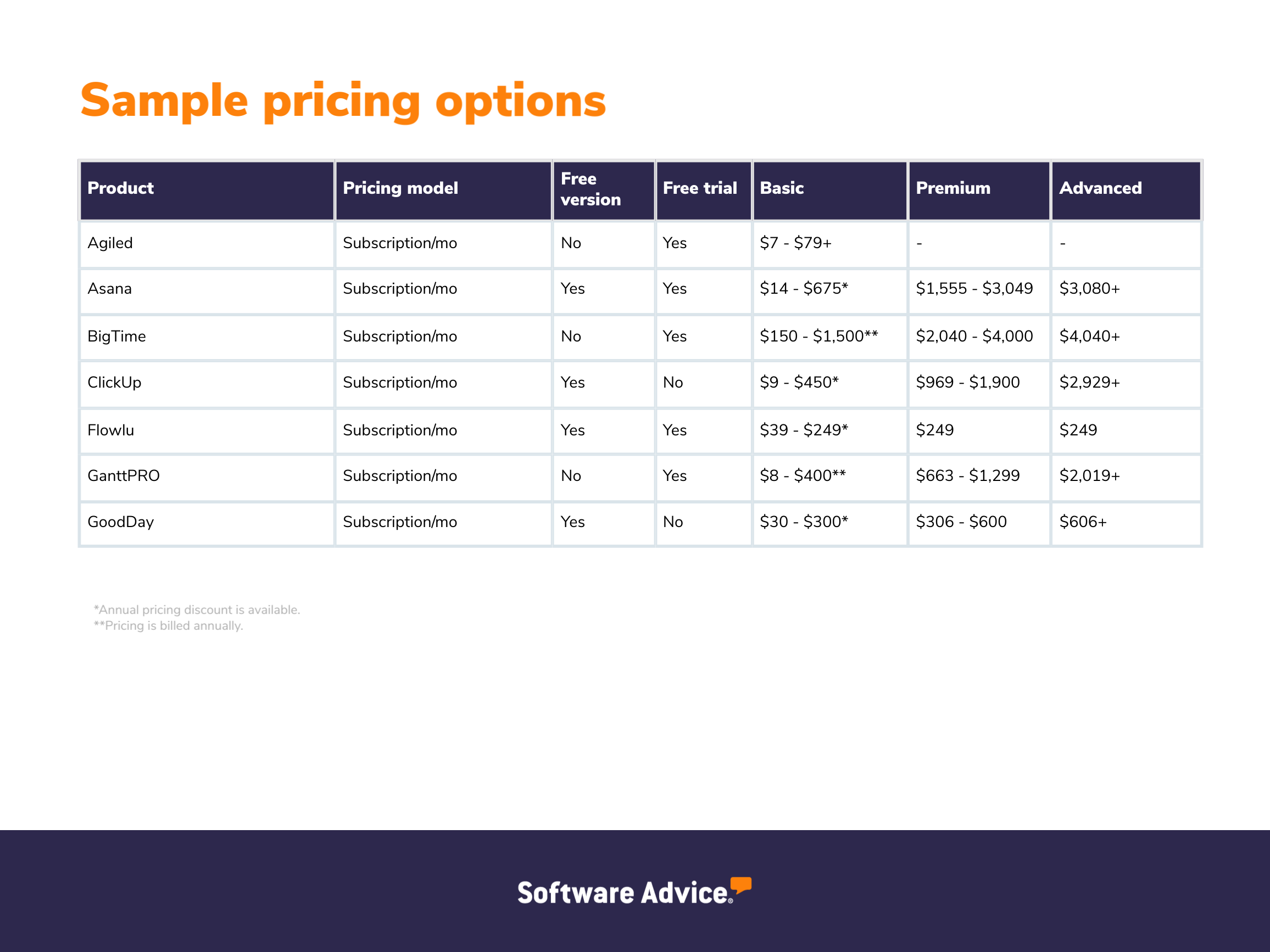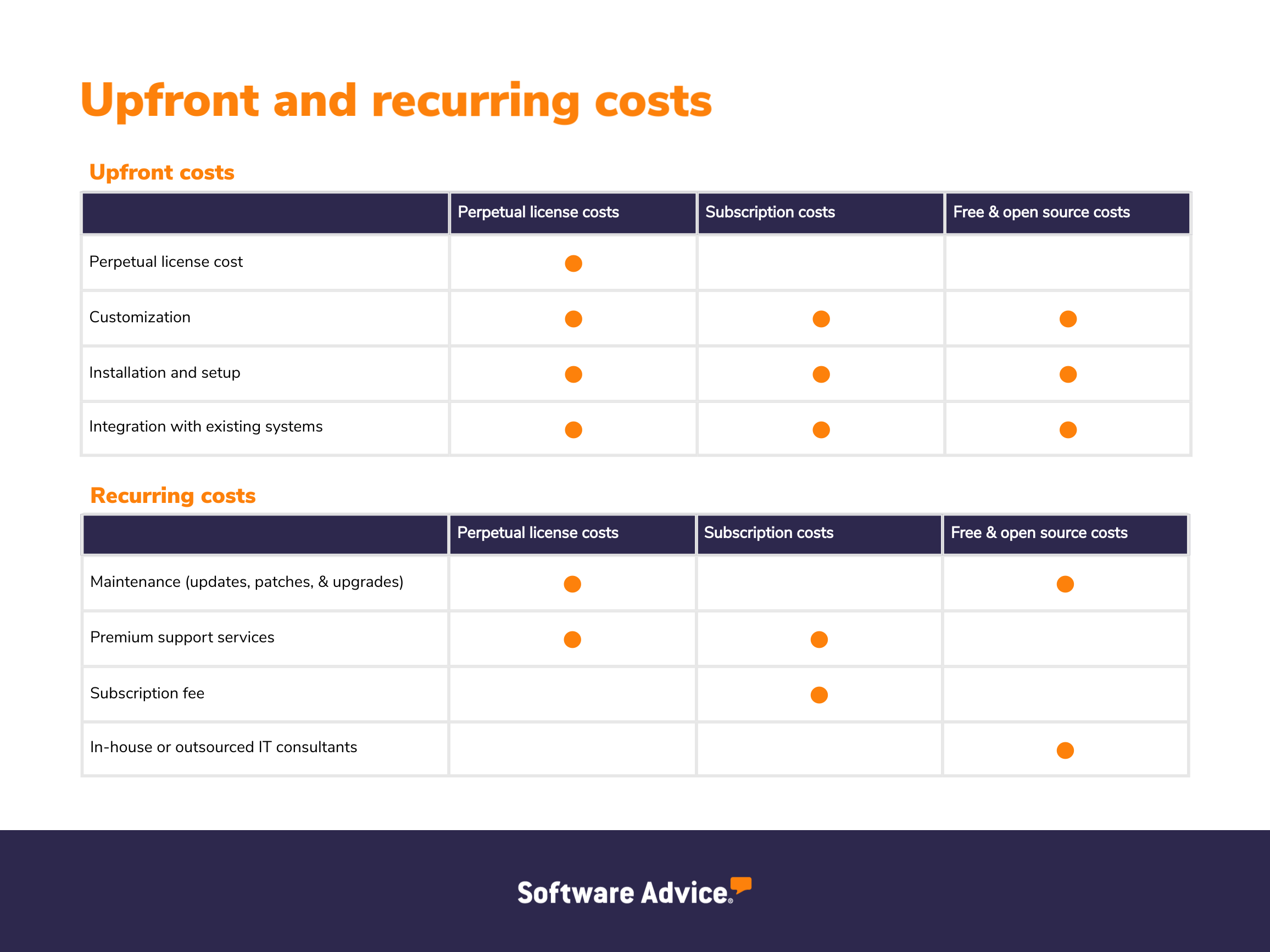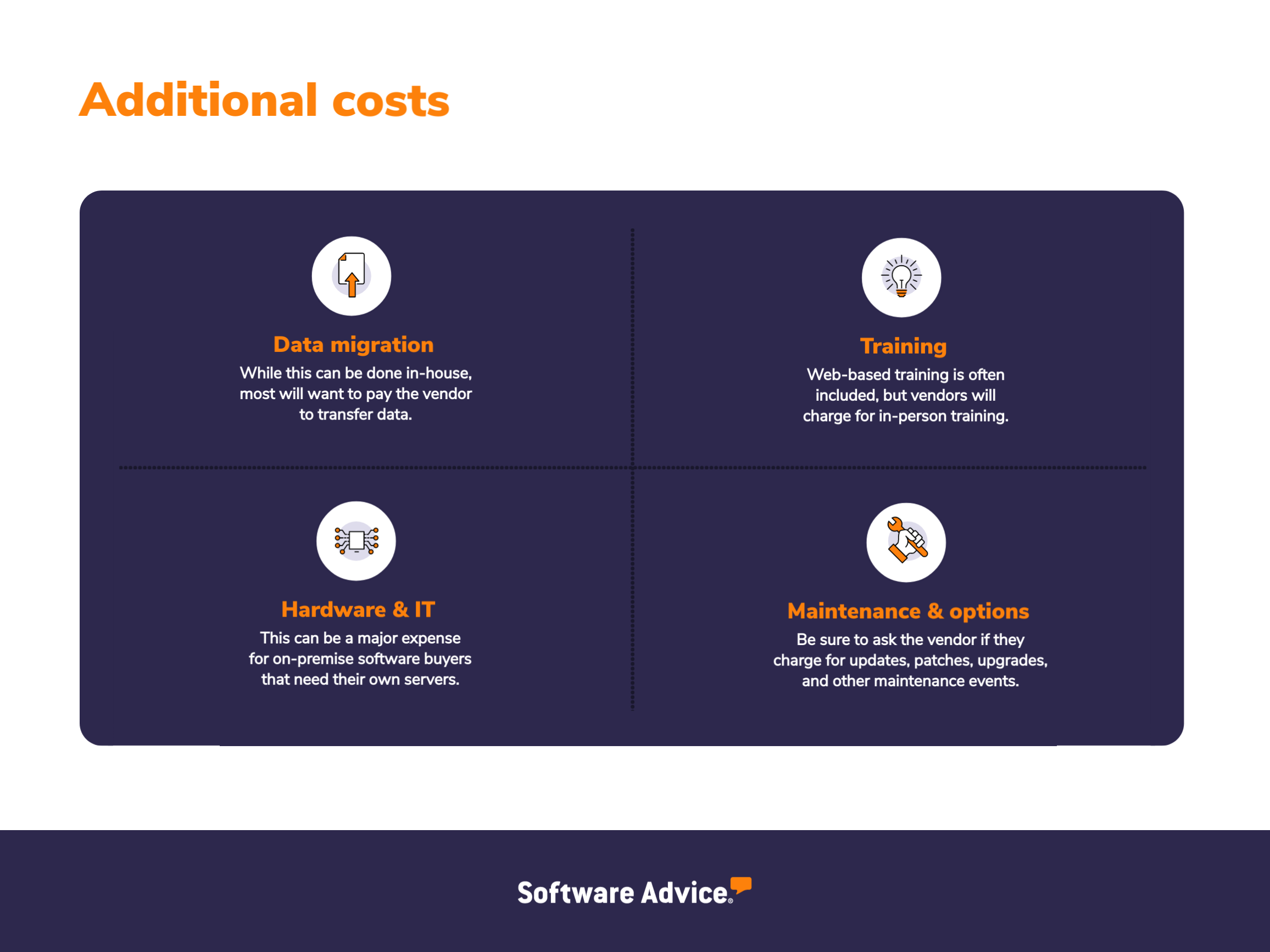A Guide to Project Management Software Pricing Models
Evaluating various project management software options and investing in a pricing plan that fits the budget as well as business requirements can be challenging for any project manager. Several crucial factors need to be considered to choose the best project management software, including the budget, number of users, required features, upfront and recurring costs, additional fees, and hidden charges.
With that in mind, we’ve put together this comprehensive guide to help you compare the pricing of top-rated project management solutions. This will help you determine which plan will provide the most value for your investment. You’ll also learn how project management tools are licensed and priced in detail.
How is project management software priced?
Project management software solutions have differentiated pricing plans/ranges determined by several factors, including software features, number of users and projects, vendor reliability, required infrastructure, business size and type, training availability, deployment options, custom branding, integrations, and storage capacity.
Types of project management software pricing models
The most common pricing model for project management solutions is a subscription-based model where users pay a recurring fee to the software vendor, on a monthly or annual basis, instead of purchasing a license. Here are a few other pricing models for project management software:
Freemium: A basic version of the software is free, with paid upgrades or add-ons for additional features.
Per user: Pricing is based on the number of users accessing the software.
Per project: Pricing is based on the number of projects managed using the software.
One-time fee: Users pay a one-time fee to access the software and its features permanently.
Pay as you go: Users are charged based on usage.
Some software providers also offer custom pricing plans or a combination of pricing models. Project management solutions typically include three different pricing plans based on the number of users:
Basic (1-50 users): Starting at $7 per month, the basic plan includes limited features and functionality but can be a good option for small businesses or teams with simple project management needs.
Premium (51-100 users): Mid-range price category can cost from $59 to $4,000 per month. This pricing plan often includes more advanced features and capabilities, such as time tracking, project progress report, and resource allocation.
Advanced (101+ users): Ranging from $249 to $4,040, advanced pricing plans include advanced features such as managing unlimited projects, workflow automation, forecasting, and portfolio management.

For reference, below is a snapshot of the costs of some popular project management software.

A note on features
Project management tools act as a single platform for individuals, project managers, or team members to track project progress from initiation to execution. These tools help businesses plan, monitor, and control project costs, schedules, and resources to deliver value and meet project success criteria. The core or basic functionalities include project planning, task management, team collaboration tool, and project tracking.
What are the upfront and recurring costs associated with project management software?
The initial expenses incurred when purchasing or subscribing to the software are upfront costs. For example, the cost of licensing, installation, setup, and training. On the other hand, the ongoing expenses associated with using the software, such as subscription fees and maintenance costs, are called recurring costs. These costs may be charged on a monthly or annual basis and can also include the costs of upgrades or additional user licenses.
Let’s look at upfront and recurring costs under the different project management software pricing models before deciding on the software implementation.

Subscription license
What is: You pay a monthly or annual fee to use the solution you have purchased for a set period of time. The typical pricing model is based on the number of users per month. There are pay-as-you-go options as well that do not have any contract and can be discontinued at any time.
Commonly used for: Cloud-based deployments, where the system is hosted by vendors on their servers and can be accessed on compatible devices over the internet.
Upfront costs: Installation or setup.
Recurring costs: A monthly subscription fee per user (can range from $5 - $200+) and premium support offerings (e.g., 24x7 phone support hours and quick ticket response time).
Hidden costs: Customization, implementation of unique company branding, and integration with existing software (such as CRM software, screen sharing, remote access, and Gantt chart).
Perpetual license
What is: Under this plan, you pay a one-time fee for a permanent license to use the project management software solution. The fee for the perpetual license can vary based on the number of users.
Commonly used for: On-premise deployments, where the system is hosted and maintained in-house on your own servers.
Upfront costs: One-time license fee and hardware (for example, servers) cost.
Recurring costs: Monthly, annual, or ad hoc maintenance (for example, updates, patches, and upgrades). Recurring costs may include premium support offerings (for example, extended phone support hours).
Hidden costs: Customization, integration, and IT staff overtime (or hiring more IT staff) to maintain servers.
Free plans
What is: You do not pay any fee to use the basic features of the project management software solution.
Commonly used by: Small business owners or project managers with limited budgets and resources.
Upfront costs: Installation/setup costs.
Recurring costs: There are no recurring costs. You can use it freely, typically with limited features.
Hidden costs: Customization, integration with existing tech stack, training, and premium support options.
What are the additional fees associated with project management software?
Once you have understood the various pricing models, it is essential to be aware of the additional fees that may be incurred when implementing new project management software. These additional costs are common across different vendors and pricing models, so it is important to include them in your budget:

Data migration: Switching to a new project management solution and transferring all business-critical data to the new one can be time-consuming and requires specialized expertise, resulting in additional data migration costs. This includes costs for expert consultation, data mapping and validation, hardware or software installation to facilitate migration, and data integrity assurance. Therefore, it’s important to consider how much the data migration will cost. Understand if there will be downtime associated with the data transfer and how much that disruption will cost.
Training: The cost of training staff on a new project management system can vary from nothing to several thousands of dollars, depending on the complexity and criticality of the software solution. Most software vendors include a variety of free online resources, such as webinars and instructional videos, to reduce training costs. Hiring an implementation specialist to train staff and minimize downtime quickly may be more costly but beneficial in the long run.
Hardware and IT: In a project management solution, hardware and IT costs may include purchasing or upgrading servers to host the software, updating employee computers or mobile devices to meet the system's technical requirements, and potentially hiring IT staff to manage and maintain the technology. These costs can be an additional expense to project management software. Before making a choice, see if there are any additional costs or upgrades required for your current infrastructure to implement the software.
Maintenance and upgrades: These refer to the expenses incurred to keep a project management software system running efficiently and up-to-date with the latest features and capabilities. Maintenance and upgrades are ongoing costs that typically occur regularly and can add up over time. Therefore, it's crucial to understand if the maintenance and upgrade services offered by the vendor are included in your software subscription or licensing fees. Alternatively, you may have in-house staff to handle maintenance and support tasks.
How to find the right project management software price range
Assess the size of your business: Solopreneurs and small-to-midsize business owners typically have a limited budget and resources due to other pressing financial priorities. They should start with a free or basic plan with limited features. On the other hand, larger businesses have a larger budget and more users, which may require them to have a more robust solution. Therefore, they can invest in a premium or advanced pricing plan depending on the business requirements.
Identify the project management features you require: Pricing plans with more advanced features and functionality tend to be more expensive than those with fewer features. For example, a basic plan costs lower than advanced plans having premium features such as resource management, time tracking, and financial management. Identifying the must-have features will help you prioritize your spending and find the pricing plan that fits within your budget while meeting your project needs.
Consider pricing commitment (subscription or long-term): Long-term deals are a commitment to purchase the software for a set period of time, typically two or three years. This pricing model may offer a lower cost per year than subscription-based pricing. Long-term deals may also include additional services such as maintenance and support, which benefits organizations with limited IT resources. If you are looking for a flexible and scalable solution, subscription-based pricing may be the best option. However, if you want a lower cost per year and additional services, a long-term deal may be more appropriate.
Check if free or open-source software works for your business needs: Free or open-source software is typically available at no cost and can be modified and distributed by users. These software products can be a cost-effective solution for businesses with limited budgets, but they may offer limited features and support. Before making a choice, evaluate the specific needs of your business and compare them to what the free or open-source software solution offers. If the solution meets your needs and has an active support community, it can be a good option for your business.
Consider the number of users: The number of users is one of the most common differences between basic, premium, and advanced pricing plans for project management software—the more users, the higher the costs. If you have up to 50 software users, you can go with a basic plan. But, if you need a tool for more than 50 users, consider investing in a premium or advanced plan. It's a good idea to choose a scalable software solution that can adapt to any changes in the number of users. Additionally, some software providers offer per-user licensing. Therefore, you should consider the number of users that will need access to the system when determining the budget for a software solution.
Common questions to ask when choosing project management software
Is there a free trial or demo version of the software? A free or trial version allows users to test the software features and functionality before committing to a purchase, ensuring that it meets your needs and is easy to use.
Are there any additional costs, such as for customization or training? Some software may require additional costs, such as customization, training, technical support, or maintenance and upgrade costs. Before you make a choice, ask the vendor about any additional fees that may be associated with the software to make an informed decision.
Are there any hidden costs or fees for data migration or integration with other systems? Some software pricing plans include hidden costs or fees for various features, such as data migration and integration with your existing tech stack. Even the free plan may have hidden charges, such as implementation costs, training costs, and data migration charges. Before making a choice, ask the software vendor about hidden charges to ensure full pricing transparency.
Are there any long-term contracts or commitments required? Ask the vendor if they associate any long-term contracts and commitments with the software. This can help you understand if you will be locked into using the software for a certain period of time and if you will face penalties for canceling or changing your subscription. Some software vendors may offer month-to-month subscriptions, while others may require longer-term commitments. It is important to understand the terms and conditions of the subscription before making a decision to ensure it aligns with your organization's needs and budget.
What are the best project management software packages?
Do the project management tools listed in this guide fall within your software budget? If yes, compare their features and read real user reviews of more than 1,000 similar products listed on our project management category page.
Sources
The products in this guide qualified for the most recent FrontRunners for project management and were highly rated by users. Only products with publicly available pricing information were included in this table. We summarized publicly available pricing sources, including vendor websites as of December 2022, beginning with the lowest monthly pricing (not including annual discounts) for packages that include the core functionality for a software category. We list pricing for more advanced packages (per user, when available) that include the core software feature(s). Your company’s needs may differ, and final pricing may vary.
NOTE: This article is intended to inform our readers about business-related concerns in the U.S. It is in no way intended to provide financial advice or to endorse a specific course of action. For advice on your specific situation, consult your accountant or financial consultant.